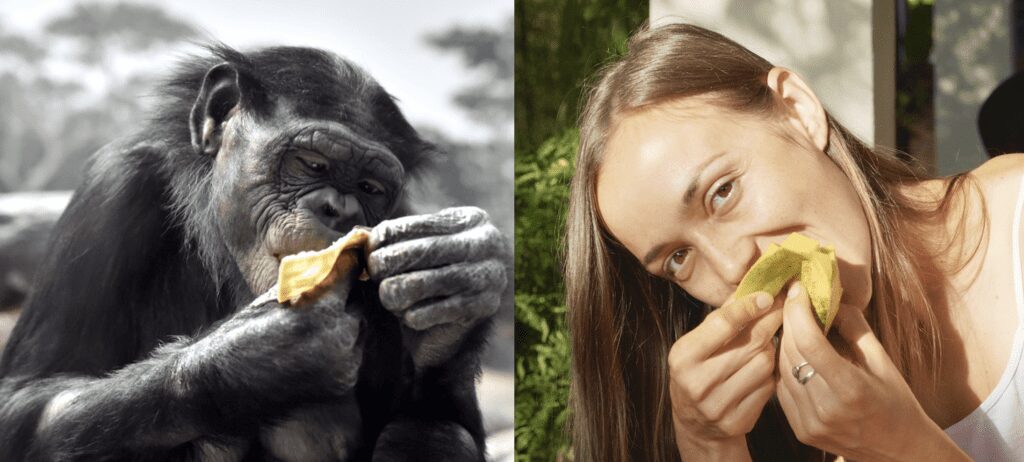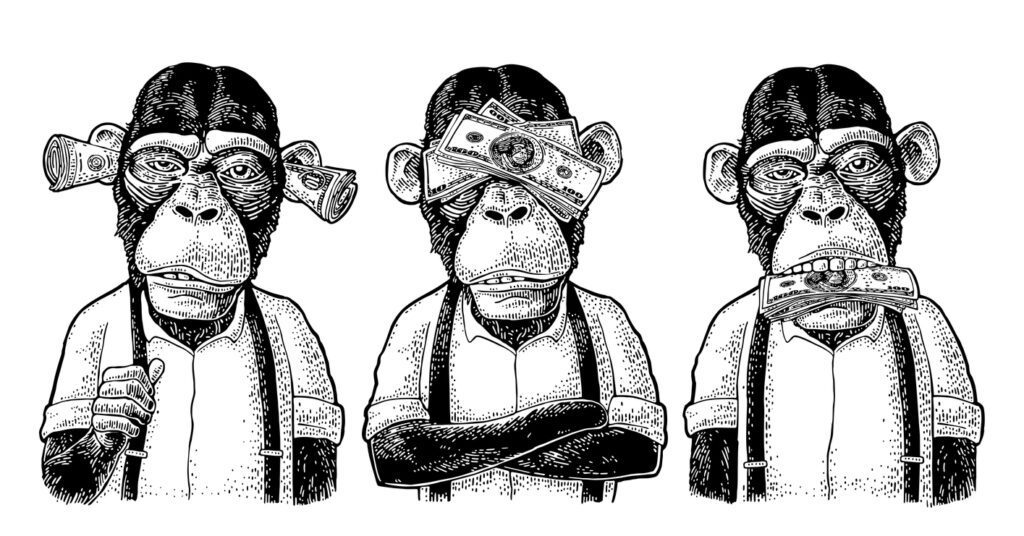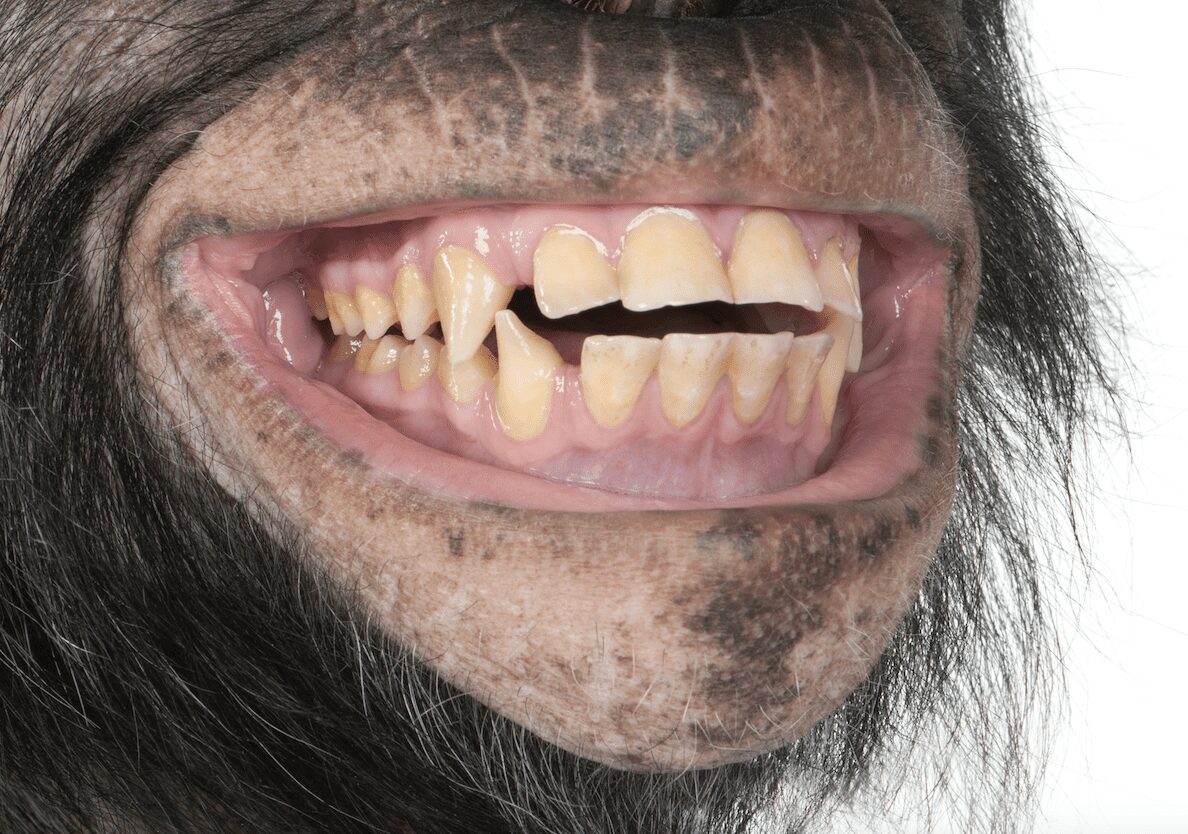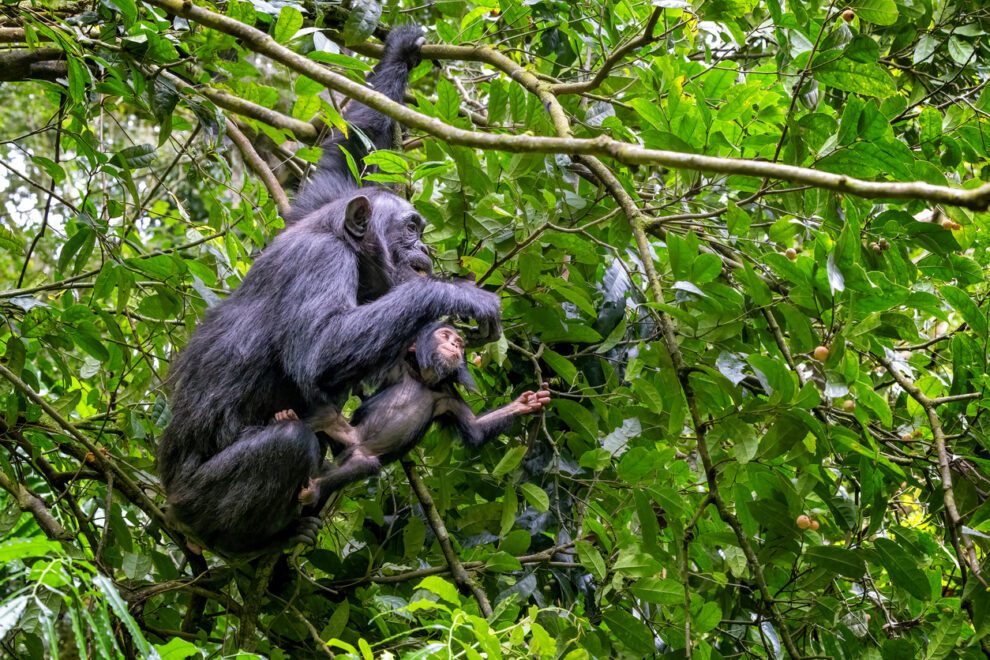Chimpanzees are tropical primates commonly described as omnivores. In their natural habitat, however, they are specialized fruit-eaters (frugivores), with fruit as their preferred food source. Therefore, chimpanzees are also classified as frugivores in primate research: Chimpanzees (Pan troglodytes) are frugivorous omnivores and bonobos (Pan paniscus) are omnivorous frugivores. Read an in-depth article on the chimps’ diet here.
“It is important to realize that, though Primates are viewed as omnivorous, they are omnivores of a very particular type in that the great majority of their foods each day come from plants.”
K. Milton, 2004
Why is it relevant to get this classification and perception of chimpanzees right? As the closest living relatives, they are the key species for humans to compare themselves. If we see chimpanzees as the fruit-loving, mostly peaceful apes instead of “aggressive monkey hunters,” it impacts how we see ourselves – and our diet!

Why do we think chimpanzees are typical omnivores?
Chimpanzees are known as omnivores, however, in scientific literature, they are referred to as frugivores for decades. The confusion about the diet of our closest relatives has consequences on how we perceive our own diet. Thus a misconception of the chimpanzee diet might have far-reaching implications for humans.
Traditionally we associate monkeys and apes with bananas! But the picture changed when Jane Goodall first reported that chimpanzees hunt smaller vertebrates, like bush pigs and smaller monkeys. It was a major discovery! But did (or does) the media draw a realistic picture of our primate cousins’ diet?

In the 90s, hunting chimpanzees were portrayed as a meat-eating species in the News – which was blown way out of proportion! Attention-gaining articles like the headline “Meat Viewed as Staple Of Chimp Diet and Mores” in The New York Times in 1995 implied that chimpanzees regularly eat meat.
The previous image of our “long-thought” peaceful, vegetarian cousins was transformed into the hunting and bloody meat eating primates – a picture which neither reflects reality nor reproduces scientific observation done by anthropologists then and now. The media has impacted the public’s perception of chimpanzees’ diet sustainably up until now.
To correct this distorted image of typical omnivory, chimpanzees should be referred to as frugivores, or frugivorous omnivores (see classification below).
Moreover, their meat consumption should be portrayed in realistic proportions. Getting an accurate picture of the chimpanzee diet and food choices helps us understand our own dietary biology. K. Milton explains here why we should get inspired by the diet primates eat in the wild.
Diet of chimpanzees described in scientific literature
Chimpanzees – like most tropical primates – have highly frugivorous diets in the wild (read more here). They preferably eat fruits whenever they are abundant. Additionally, chimpanzees forage for nuts, leaves, other plant foods, and insects and can – rarely – eat meat. Read more on anatomical and physiological adaptations of frugivorous primates here.
Unfortunately, the sub-category “frugivorous” is hardly ever mentioned outside scientific literature, and therefore, most people erroneously perceive Chimpanzees as typical omnivores that regularly eat meat and as a consequence see our own species-appropriate diet as a “typical” omnivore diet. Thus, specifying the dietary classification of chimpanzees and bonobos matters!
Here are some excerpts from scientific literature describing the dietary pattern of chimpanzees:
- “Chimpanzees are highly frugivorous; over 70% of the diet of most populations consists of ripe fruit.” (Stanford, C. B. & Bunn, H.T., Meat-Eating and Human Evolution, 2001)
- “Although they are mainly frugivorous, and meat composes less than 5% of the diet annually.“ (Stanford, C. B. & Bunn, H.T., Meat-Eating and Human Evolution, 2001)
- A fecal biomarkers analysis (Sistiaga et al. 2005) backed up that some chimpanzee populations consume around 5%, and some individuals up to 10% meat. However, they also reveal that other analyzed populations are high-carb consumer, with very little animal-based food in their diet, and eat meat only around once a month: “little is known about the proportions of animal protein intake necessary to influence hominin biology… Meat intake in common chimpanzees has been estimated to be around 5% of the diet in some populations and up to 10% in some individuals… However, the Kanyawara chimpanzees are not frequent hunters. Their diet includes ~75% ripe fruits and ~20% leaves and piths, all of which supply energy in the form of carbohydrates and protein rather than lipids… Insect-eating by Kanyawara chimpanzees is extremely rare… The average chimpanzee in Kanyawara probably eats meat only about once per month…” (Sistiaga A. et al., 2015)
- “Most nonhuman primates prey on vertebrates… However, meat typically accounts for only small proportions of feeding time and of total energy and protein intake, and quantitative data are inconsistent with the energy shortfall hypothesis. Plant Source Foods and/or invertebrates are presumably the main protein sources, even for chimpanzees.” (David P. Watts; Meat eating by non-human primates: a review and synthesis, 2020)
- “Chimpanzee diets are highly variable, but in all cases dominated by ripe fruit… The diet was dominated by the fruit of four species and leaves of two species, although the composition of the diet varied from month to month, remaining diverse. Figs were consumed throughout much of the year, and in consequence, should perhaps be regarded as a staple, rather than fallback, food.” (Newton-Fisher N.E., The diet of chimpanzees, 2001)
- “Fruit, including figs, comprised most of the diet. ” Watts, D.P. et al. Diet of chimpanzees (Pan troglodytes schweinfurthii) at Ngogo, Kibale National Park, Uganda, 2. temporal variation and fallback foods, 2012)
- In a Harvard study in Uganda, Chimpanzees are referred to as specialized frugivores. (Wrangham et al. The Value of Figs to Chimpanzees, 1993)
According to the Jane Goodall Institute, chimpanzees eat figs (around 50% of the diet), fruits (mangoes, bananas, etc.), which make up the bulk, as well as tender leaves, nuts, and seeds. Additional foods are flowers, tubers, and bark. They eat over one hundred types of plant species! Insects make up a few percent of the diet. Animal products (including eggs, insects, and meat) account for around 6% of the chimpanzee diet. Thus, meat makes up a small fraction of around 1-2%. Goodall calculated 4,2% insects and 1,4 % meat in the diet of Gombe chimpanzees.
Dietary classification of chimpanzees
Dietary classifications don’t say much about the actual diet of a species: Generally non-binary classifications are artificial – they are attempts to clear-cut a natural, complex spectrum into boxes. Those classifications hardly give us a good insight into what really happens in nature. This is also true for dietary patterns of animal in the wild. Let’s look how this plays out in the case of chimpanzees:
Chimpanzees are classified as both, omnivores and frugivores!
Chimpanzees (Pan troglodytes) are frugivorous omnivores: chimpanzees are placed in the category of omnivores, and the sub-category of frugivores. Bonobos (Pan paniscus) are omnivorous frugivores.
Emphasizing this detailed classification is essential to accurately represent the dietary biology of our closest relatives, as it reflects that chimps can eat animal-based and plant foods, but they forage for fruits most of the time.
Therefore, the classification of chimpanzees as omnivores is not wrong, but it is imprecise: the primates are able to eat plants and animal foods, which is the criteria for the omnivore classification. In the wild, however, chimpanzees eat primarily ripe fruits, which is why they are also classified as frugivores.
Depending on fruit availability, chimps forage for other types of plant foods and animal-based foods like insects, eggs, and meat. But the observed portion of animal foods in their diet is tiny, and the quantity of meat is negligible… or sometimes even seems non-existent. Read more on the diet of chimpanzees in the wild here.
The need to correct the image of the chimpanzees’ diet is real
Correcting the image of the chimpanzees’ diet is long overdue and essential for our understanding the human diet!
Chimpanzees are frugivores and should be referred to as such: despite their highly frugivorous diet described by primate research and their classification as omnivorous frugivores, chimpanzees, unfortunately, are called “omnivores” – this creates a misconception that has implications on our own classification:
Humans share many frugivorous traits with chimpanzees, which is why the question “Are we frugivores, too?” is more than justified and should be addressed and taken seriously! The question here arises: Could conflicts of interest play a role in why the image of the natural diet of great apes is distorted?


How similar are chimpanzees and humans in terms of nutritional requirements? They are known to be highly similar! The nutrient requirements are nearly identical, which is why the RDAs for humans are used for dietary guidelines for chimpanzees in captivity. Vice versa, studying the natural chimpanzee diet can be just as useful to understand the human natural diet.
Check out some of the fascinating anatomical and physiological adaptations that have evolved with high-fruit diets:

Go to frugivore adaptations and specializations for fruit-eating here.
References
- Milton, K. (2004) ‘Ferment in the family tree: Does a frugivorous dietary heritage influence contemporary patterns of human ethanol use?’, Integrative and Comparative Biology, 44(4), pp. 304–314. doi:10.1093/icb/44.4.304.
- Our Legacy of Science (2018) Jane Goodall Institute USA. Available at: https://janegoodall.org/our-story/our-legacy-of-science/ (Accessed: April 13, 2023).
- Kopytoff, V.G. (1995) Meat viewed as staple of Chimp Diet and mores. The New York Times. The New York Times. Available at: https://www.nytimes.com/1995/06/27/science/meat-viewed-as-staple-of-chimp-diet-and-mores.html (Accessed: April 13, 2023).
- Craig Britton Stanford, Henry T. Bunn Meat-Eating and Human Evolution; Oxford University Press; 2001; p.127
- Craig Britton Stanford, Henry T. Bunn; Meat-Eating and Human Evolution; Oxford University Press 2001; p.124
- Milton, K. (1999) “Nutritional characteristics of wild primate foods: Do the diets of our closest living relatives have lessons for us?,” Nutrition, 15(6), pp. 488–498. Available at: https://doi.org/10.1016/s0899-9007(99)00078-7.
- Sistiaga, A. et al. (2015) “New insights into the evolution of the human diet from faecal biomarker analysis in wild chimpanzee and gorilla faeces,” PLOS ONE, 10(6). Available at: https://doi.org/10.1371/journal.pone.0128931.
- Watts, D.P. (2020) “Meat eating by nonhuman primates: A review and synthesis,” Journal of Human Evolution, 149, p. 102882. Available at: https://doi.org/10.1016/j.jhevol.2020.102882.
- Newton-Fisher, N.E. (1999) “The diet of chimpanzees in the Budongo Forest Reserve, Uganda,” African Journal of Ecology, 37(3), pp. 344–354. Available at: https://doi.org/10.1046/j.1365-2028.1999.00186.x.
- Watts, D. P. et al. (2011) “Diet of chimpanzees (Pan troglodytes schweinfurthii) at Ngogo, Kibale National Park, Uganda, 2. Temporal Variation and Fallback Foods,” American Journal of Primatology, 74(2), pp. 130–144. Available at: https://doi.org/10.1002/ajp.21015.
- Wrangham et al. 1993; The Value of Figs to Chimpanzees. International Journal of Anthropology; Vol.14; p.243-256
- Dani Sarusi, 10 things chimpanzees eat. Jane Goodall (2022) (available at https://janegoodall.ca/our-stories/10-things-chimpanzees-eat/).
- W. C. Foundation, What do chimpanzees eat? WCF | What they eat (available at https://www.wildchimps.org/about-chimpanzees/what-they-eat.html).
- No author (2020) Buy a chimp a meal, Chimfunshi Wildlife Orphanage. Available at: https://chimfunshiwildlife.org/appeal/buy-a-chimp-a-meal/ (Accessed: April 26, 2023).

